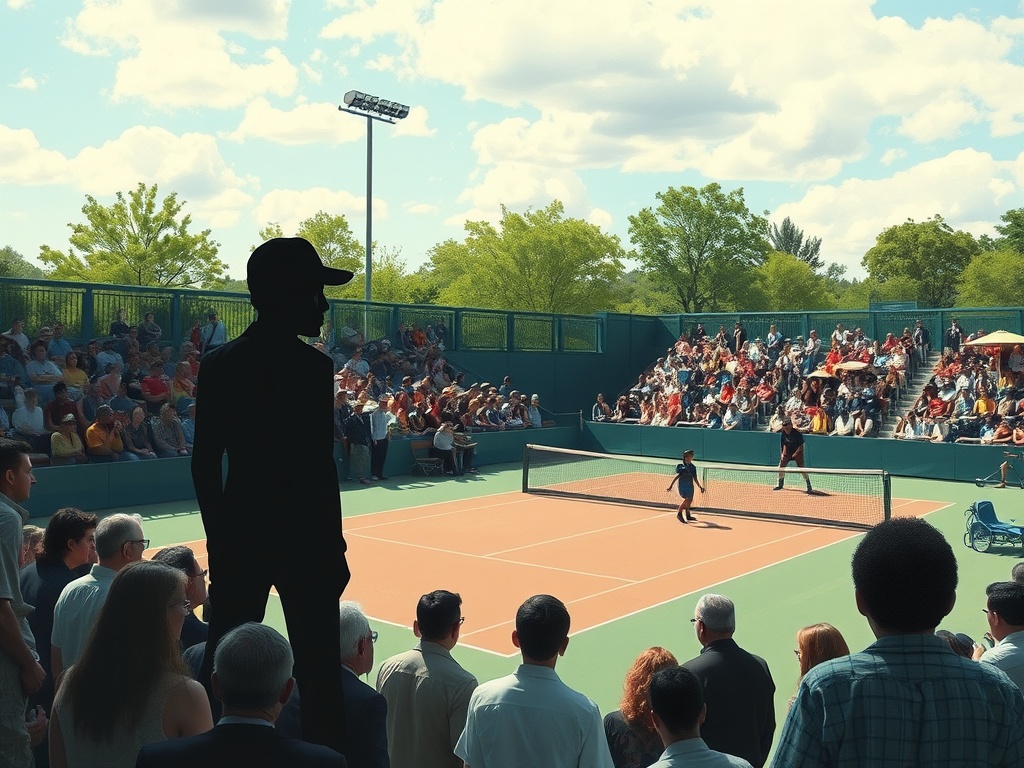Emma Raducanu’s Distressing Experience at the Dubai Tennis Championships
Emma Raducanu’s emotional breakdown at the Dubai Tennis Championships has sent tremors through the world of sports. Here we have a Grand Slam champion and a globally recognized athlete, yet she is fundamentally a 22-year-old woman who felt compelled to seek refuge behind the umpire’s chair in distress due to the actions of a man in the crowd. Her reaction was entirely justified, especially considering she had previously encountered this “fixated” individual in a public setting just the day before.
The incident that unfolded on Tuesday was particularly unsettling as it occurred live on television, exposing the vulnerability of athletes to such alarming situations. However, perhaps this is a moment for reflection rather than mere shock.
According to the Crime Survey for England and Wales, the Office for National Statistics defines stalking as “two or more incidents causing distress, fear, or alarm.” This can include a range of behaviors, from receiving obscene or threatening letters, emails, or messages, to being followed, watched, or having someone loitering around one’s home or workplace. The latest figures reveal that one in five women (20.2 percent) have fallen victim to stalking, compared to only 8.7 percent of men.
Understanding the Stalking Threat in Tennis

While there are no definitive statistics to ascertain whether female tennis players are more vulnerable than their counterparts in other sports, tennis has witnessed a greater number of high-profile stalking cases. A particularly notorious incident dates back to 1993 when Monica Seles was stabbed on court in Hamburg by a deranged fan obsessed with her rival, Steffi Graf.
Similarly, Serena Williams faced a terrifying situation when a man attempted to break into Wimbledon in 2012 to see her. Raducanu herself has not been immune to the threat of stalking, as she had a stalker who appeared at her home three times before being issued a five-year restraining order in 2022.
While on-site harassment of the nature experienced by Raducanu is relatively rare on the Women’s Tennis Association (WTA) circuit, it is still a concerning reality. British No 1 Katie Boulter revealed in a December interview with The Guardian that she was followed after leaving Queen’s Club, with a car tailing her for three miles to Sloane Square. Alarmingly, she also received physically threatening messages on social media while at the Nottingham Open, prompting security to eject the perpetrator after the WTA was alerted.
Last year, American player Danielle Collins spoke about security issues affecting “many” women on tour. She recounted a disturbing incident where an individual tracked down her family’s workplace and called them. This experience led her to avoid going out alone and made her uncomfortable in crowded spaces. Just last month, Coco Gauff responded to a social media post by American sprinter Gabby Thomas, who shared her experiences of being harassed by a group of middle-aged men at airports. Gauff echoed this sentiment, stating, “This happens to me too… my theory is maybe someone at the airport tips them off.”
These players have bravely shared their experiences regarding the ongoing issue of harassment in the sport. The instances mentioned here are just a fraction of what athletes face regularly.
The Hidden Struggles of Female Athletes
Most cases of stalking and harassment often go unreported, occurring quietly behind the scenes. Such issues can manifest as incessant messages from obsessive users on social media or distressing in-person encounters, similar to Raducanu’s recent experience. Despite the looming threat, these athletes continue to put on brave faces and perform, all while being aware that danger could be lurking at any moment.
Tennis players may find themselves more susceptible to such harassment due to the nature of their profession. They traverse the globe from tournament to tournament, often traveling alone or accompanied by just one or two individuals, such as an agent, parent, or coach. On the court, they compete in close proximity to fans, who are often just an arm’s length away. During matches, when players move to the towel box, spectators are right there, scrutinizing their every move. In certain tournaments, players are required to navigate through crowds to reach their courts. This unique aspect of the sport enhances the fan experience, allowing for an intimate connection with the action, yet incidents like the one Raducanu faced compel us to rethink this level of access.
On social media, tennis players receive both adoration and vitriol. Caroline Garcia of France brought attention to the harassment players face from online gamblers, who bombard them with abuse following losses, exploiting their emotional vulnerabilities. Garcia criticized both the tournaments and the sport for continuing to partner with such gambling entities.
The WTA has publicly stated that “player welfare and safety are top priorities,” demonstrating their commitment to safeguarding athletes. Their recent expansion in dedicated staff and resources highlights this focus. They have instituted a safeguarding director and additional support personnel, created a comprehensive safeguarding code of conduct for all WTA Tour participants, and introduced a mandatory safeguarding education module for anyone seeking a WTA Tour credential. Furthermore, mental health care providers are available in person or via phone at all tournaments. In a significant move, the WTA partnered with the International Tennis Federation, United States Tennis Association, and All England Lawn Tennis Club last month to launch Threat Matrix, an AI-powered monitoring service aimed at protecting athletes from online threats and abuse.
While strides are being made to enhance player safety, Raducanu’s distressing encounter in Dubai serves as a stark reminder of the persistent vulnerabilities athletes face in their careers.

